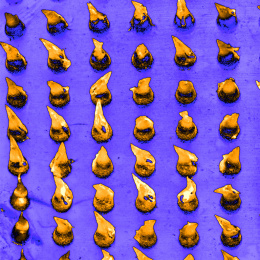Porosity of Microneedles for Immunotherapy 2
Porosity of Microneedles for Immunotherapy 2
Núria Puigmal Domínguez, Gonzalo Muñoz Taboada, Natalie Artzi
Koch Institute at MIT, Institute of Medical Engineering and Science
We are developing polymeric microneedle patches to locally deliver novel immunotherapies, each one of these microneedles have a size of only 500mm, they are so small that they don’t reach your nerves and their application is painless. Our microneedle platform is made of hyaluronic acid, which is a biocompatible polymer. Once inserted on the skin, its porous structure, allows cells to migrate inside. We have engineered the hyaluronic acid to have on-demand degradation, allowing that once the patch is retrieved, we can dissolve the needles to analyze the cell population that has been recruited. This monitoring is critical to understand in real time the response to the therapy and titrate the personalized therapy.
The microneedle structure must be strong enough to penetrate the skin, but also having a porous enough structure that will allow cells to migrate inside. In the images it can be seen how the tip of the needles has a lower porosity and stronger mechanical properties while the lower regions display a much higher porosity.






